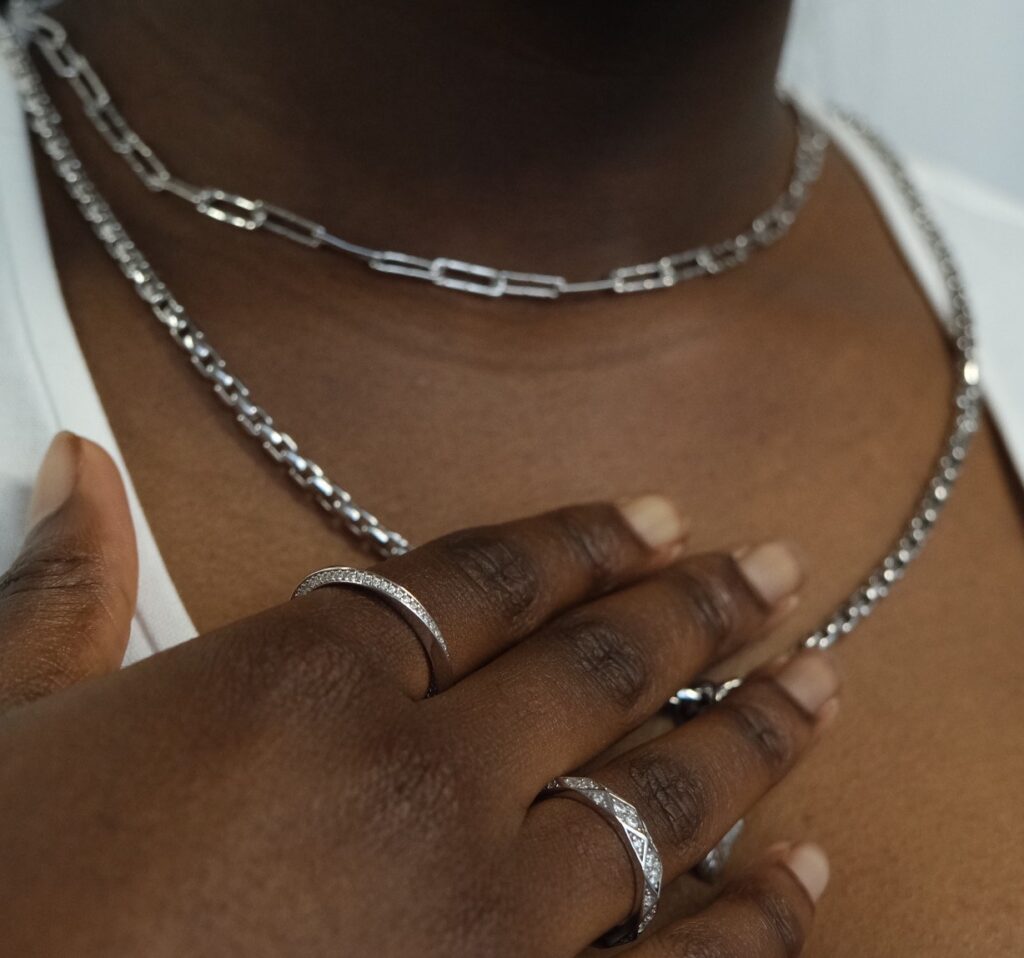Precious Metals
THE ART OF PROMISE RING: SYMBOLISM, STYLES, AND TIMELESS TRADITIONS
A diamond cut is a key factor to consider when choosing your next piece of diamond jewelry.
By Chinwe, Chief Creative Officer
What are promise rings? They are rings given and worn as a sign of devotion, loyalty, and commitment to another person. They are often seen as a precursor to an engagement, but they can also be given for other reasons, such as friendship, abstinence, or simply love. In this blog post, we will explore the history, evolution, significance, and symbolism of promise rings.
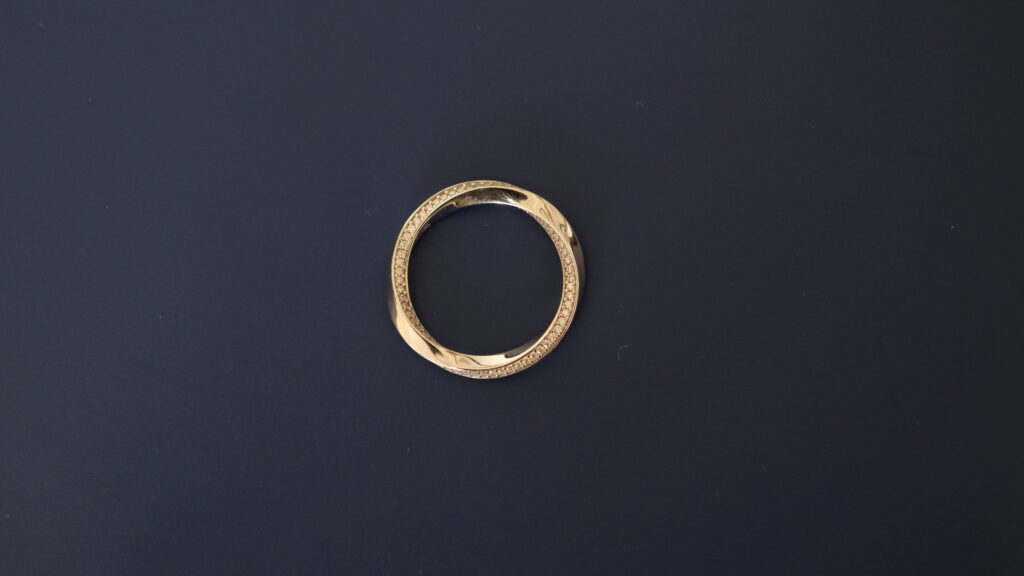
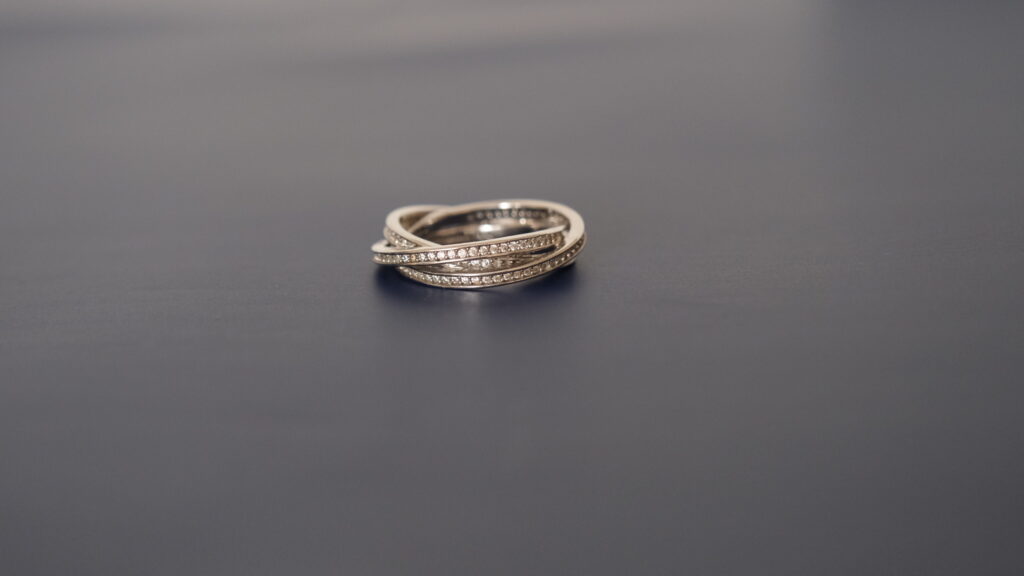
-
Eternity Twirl Round Cut Ring 18K White Gold- 0.36ct
18K White Gold
£890 Select options This product has multiple variants. The options may be chosen on the product page -
Serenity Band Ring – 18K White Gold 1.19ct
18K White Gold
£2,775 Select options This product has multiple variants. The options may be chosen on the product page
The History and Evolution of Promise Rings
Promise rings have a long and rich history that dates back to ancient times. The promise ring has been given as a form of commitment since the Roman era. Roman brides, who were required to observe a waiting period before marriage, used to receive rings made of iron before becoming betrothed. These rings symbolized strength and durability.
In the 16th century England, promise rings became more romantic with the introduction of posey rings. These were gold rings engraved with poetic phrases or messages of love. For example, a posey ring might say “I love you more than words can say” or “You are my heart’s delight”. These rings were popular among lovers and friends alike.
During the Georgian and Victorian eras, promise rings evolved into acrostic rings. These were rings that spelled out words or messages in gemstones. For example, a ring with ruby, emerald, garnet, amethyst, ruby, and diamond might spell out “REGARD”, meaning “I have high esteem for you”. These rings were also given as tokens of affection and admiration.
In the 20th century, promise rings became more associated with pre-engagement and purity. During the World War II, many soldiers gave their girlfriends promise rings before leaving for war. These rings represented their hope to return and marry them someday. In the 1990s and 2000s, promise rings gained popularity among celebrities and young people who wanted to pledge their abstinence until marriage. These rings were often engraved with words like “True Love Waits” or “Love is Patient”.
The Significance and Symbolism of Promise Rings
Today, promise rings are still given and worn as a sign of commitment and fidelity to another person. They can have different meanings depending on the context and the intention of the giver and the receiver. Some common reasons why people give or wear promise rings are:
- To express their love and devotion to their partner.
- To promise to get engaged or married in the future.
- To celebrate a milestone or anniversary in their relationship.
- To show their support and solidarity to their friend.
- To honor their faith and values.
- To make a personal vow or goal
Promise rings can also have different symbols that convey different messages. Some common symbols are:
- Hearts: Hearts represent love, passion, and affection. Heart-motif promise rings show that you’ve given her your heart.
- Infinity: Infinity represents eternity, continuity, and endlessness. Infinity-motif promise rings show that your love is forever.
- Knots: Knots represent connection, unity, and strength. Knot-motif promise rings show that you are tied together by a bond that cannot be broken.
- Claddagh: Claddagh is a traditional Irish symbol that consists of two hands holding a heart topped by a crown. Claddagh-motif promise rings show that you offer your friendship (hands), love (heart), and loyalty (crown) to your partner.
- Gemstones: Gemstones represent different qualities, emotions, and meanings. Gemstone-motif promise rings show that you value your partner’s personality, traits, or birth month.
Promise rings are a beautiful way to express your feelings and intentions to someone you care about. They are more than just jewelry; they are symbols of love and commitment that can last a lifetime
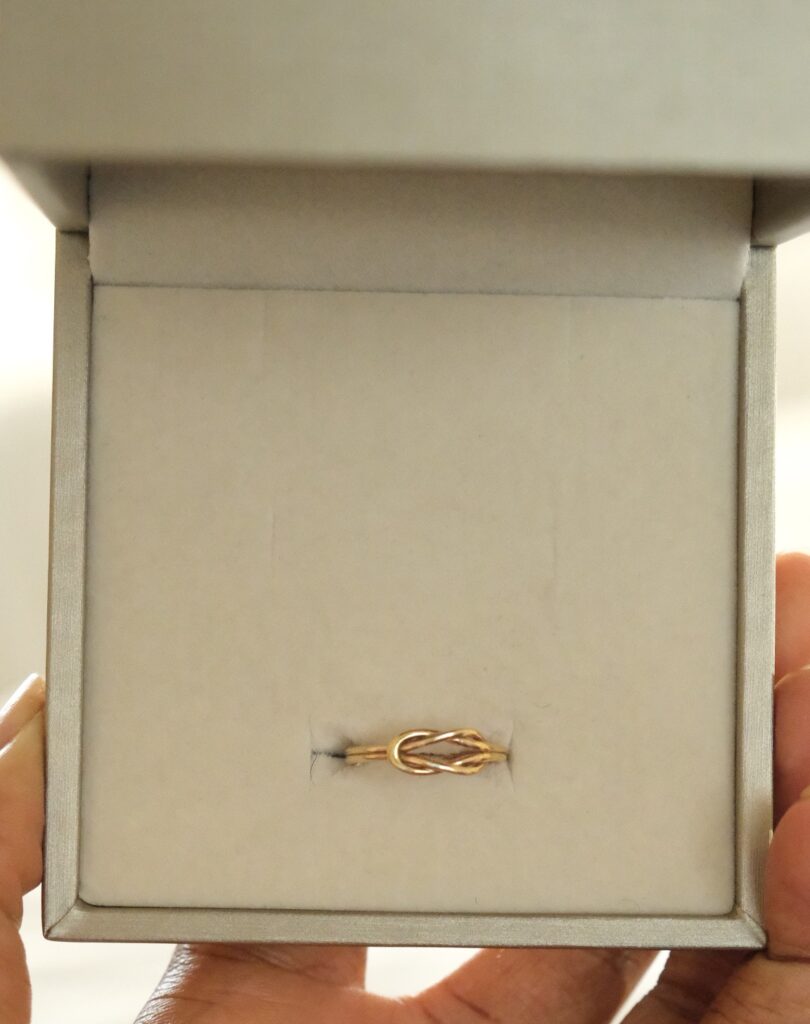
-
Eternity Band Ring – 18K Gold 1.04ct
18K Gold
£1,350 Select options This product has multiple variants. The options may be chosen on the product page -
Knot Ring – 18K Rose Gold
18K Rose Gold
£350 Select options This product has multiple variants. The options may be chosen on the product page -
Love Ring – 18K White Gold
18K White Gold
£300 Select options This product has multiple variants. The options may be chosen on the product page
Historical Roots of Promise Rings
Promise rings are a popular way of expressing love and commitment in modern times, but they have a long and fascinating history that spans centuries and cultures
Ancient traditions: Posy rings, betrothal rings, and love tokens
The concept of giving a ring as a sign of promise or devotion can be traced back to ancient civilizations, such as the Egyptians, Greeks, and Romans. In ancient Rome, for example, couples who were legally required to wait for a certain period before getting married would exchange iron rings as a symbol of their betrothal. These rings were worn on the left ring finger, which was believed to have a vein that connected directly to the heart. In medieval Europe, posy rings became popular as romantic gifts. These were gold or silver bands engraved with poetic verses or messages of love, such as “I am yours” or “Love conquers all”. Posy rings were often exchanged by lovers or friends, and sometimes used as wedding rings. Another type of ring that expressed affection and loyalty was the acrostic ring, which emerged in the Georgian and Victorian eras. These rings used gemstones to spell out words or initials, such as “regard” (ruby, emerald, garnet, amethyst, ruby, diamond) or “dearest” (diamond, emerald, amethyst, ruby, emerald, sapphire, topaz). Acrostic rings were also given as tokens of friendship or admiration.
Renaissance and Victorian eras: Symbolism and cultural significance
The Renaissance and Victorian periods saw an increase in the use of symbolism and sentimentality in jewelry, especially in rings. Rings were often designed with intricate motifs and hidden meanings, such as flowers, hearts, hands, snakes, or knots. Some of these symbols represented love, fidelity, eternity, or friendship. One of the most famous examples of a symbolic ring is the Claddagh ring, which originated in Ireland in the 17th century. The Claddagh ring features two hands holding a heart topped with a crown, which symbolize friendship, love, and loyalty. The Claddagh ring can be worn in different ways to indicate the wearer’s relationship status: on the right hand with the heart facing outwards means single; on the right hand with the heart facing inwards means in a relationship; on the left hand with the heart facing inwards means engaged or married. Another example of a meaningful ring is the gimmel ring, which was popular in Europe from the 16th to the 18th century. The gimmel ring consists of two or three interlocking bands that form one ring when joined together. The bands often had engravings or gemstones that matched when aligned. Gimmel rings were used as engagement or wedding rings, and sometimes had a hidden compartment that contained a lock of hair or a portrait of the beloved.
Transition to promise rings in modern times
Different cultural interpretations
Promise rings have a long history that dates back to ancient times, when they were known as betrothal rings and signified a promise of marriage in the future. In 16th-century England, young lovers exchanged “posy rings”, which were engraved with romantic verses or sayings, as a token of their affection and commitment. These rings were usually made of more affordable materials like silver or copper, and were worn on the index finger. Over time, the custom of exchanging posy rings evolved into the modern practice of giving promise rings.
Today, promise rings are popular in many cultures and countries, but they may have different meanings and names. For example, in Brazil, couples wear “alianças de compromisso”, which are matching silver bands worn on the right ring finger to show that they are in a serious relationship. In some parts of Europe, such as France and Italy, couples wear “fede rings”, which feature two clasped hands as a symbol of trust and faithfulness. In some Asian cultures, such as China and Korea, couples wear “couple rings”, which are matching rings that can be worn on any finger to show their love and loyalty.
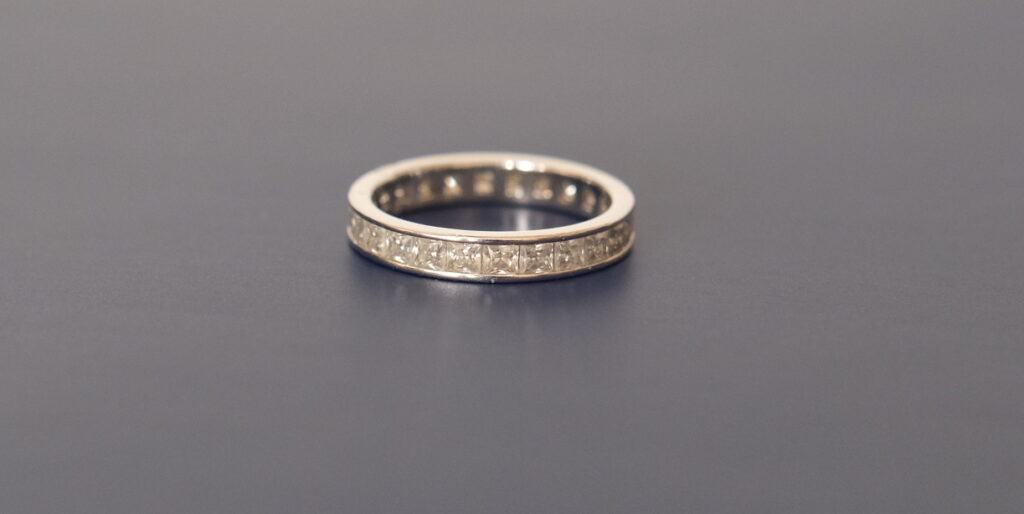
-
Eternity Band Ring – 18K Gold 1.04ct
18K Gold
£1,350 Select options This product has multiple variants. The options may be chosen on the product page -
Princess Cut Ring – 18K White Gold – 1.78ct
18K White Gold
£2,800 Select options This product has multiple variants. The options may be chosen on the product page -
Serene Ring – 18K White Gold 0.20ct
18K White Gold
£1,612 Select options This product has multiple variants. The options may be chosen on the product page
Promise ring vs. engagement ring
A promise ring may point towards an engagement ring, but their connotations are quite different. A promise ring signifies a promise to take the relationship seriously. It also symbolizes hope for the relationship’s future development. It does not promise marriage, however, like engagement rings do.
A promise ring can be given for various reasons, such as expressing love, fidelity, or a personal vow. It can also be given as a placeholder for an engagement ring when the couple is not ready to get engaged due to financial, age, or geographical reasons. A promise ring can be worn on any finger, but it is usually worn on the left ring finger to avoid confusion with an engagement ring.
An engagement ring is a symbol of a formal agreement to get married in the near future. It represents a higher level of commitment and responsibility than a promise ring. It also implies that the couple has discussed their plans for marriage and has agreed on a timeline. An engagement ring is typically more expensive and elaborate than a promise ring, often featuring a diamond or other precious gemstone. An engagement ring is always worn on the left ring finger until it is replaced by a wedding ring.
Common occasions for giving/receiving promise rings
There is no fixed rule or tradition for when to give or receive a promise ring. However, some common occasions include:
– Valentine’s Day: This is a romantic day to celebrate love and affection, and a perfect opportunity to give a promise ring to your partner.
– Anniversary: This is a meaningful day to commemorate your relationship milestones and achievements, and a great time to give a promise ring to your partner.
– Birthday: This is a special day to honor your partner’s life and personality, and a wonderful chance to give a promise ring to your partner.
– Graduation: This is an important day to celebrate your partner’s academic success and future goals, and a nice occasion to give a promise ring to your partner.
– Christmas: This is a festive day to share joy and gratitude with your partner, and a lovely moment to give a promise ring to your partner.
– Any day: You don’t need a specific day or reason to give or receive a promise ring. You can do it whenever you feel ready and inspired to express your commitment and hope for your relationship.
Styles and Design of Promise Ring
Classic Styles: Classic promise ring styles endure through time, offering timeless elegance and simplicity. The solitaire, featuring a single, prominent gem, symbolizes singular devotion. Heart-shaped promise rings eloquently express love and affection, while infinity bands represent a commitment to eternal and limitless love.
Gemstone Choices and Their Symbolic Meanings: Gemstones add a personalized touch to promise rings, each carrying unique symbolism. For instance, diamonds signify strength and endurance, while sapphires represent loyalty. Amethyst embodies deep love, and emeralds symbolize renewal and growth. Understanding the meanings behind gemstones helps individuals select one that resonates with their promise’s essence.
Personalized Touches: Engravings and Custom Designs: Personalization elevates promise rings, transforming them into cherished, one-of-a-kind symbols. Engravings allow couples to inscribe meaningful dates, initials, or messages, adding sentimental value. Custom designs offer endless possibilities, enabling the incorporation of unique elements, ensuring the promise ring is a true reflection of the couple’s connection.
Etiquette of Promise Rings
A promise ring is a serious thing, because it represents a sincere and lasting commitment to someone. It should not be given lightly or impulsively, but only after careful consideration and mutual agreement. And while there are no hard and fast rules on which finger to wear a promise ring, but some common choices are the ring finger of the left or right hand, the middle finger of the left hand, or the pinky finger of either hand. The choice depends on personal preference, cultural background, and the meaning of the promise. Some people may also choose to wear their promise rings on a necklace or a bracelet instead of a finger. Also, the best way you give a promise ring depends on your relationship and the message you want to convey. You don’t have to kneel when giving a promise ring, unless you want to make it more romantic or formal. You can also choose to give it in a special location, such as where you first met, where you had your first kiss, or where you said “I love you” for the first time. You can also accompany the ring with a heartfelt speech, a handwritten note, or a poem that explains the meaning of your promise.
A promise ring should also be respected and honored by both parties, and not taken for granted or broken without good reason. For couples, the timing of giving a promise ring varies, but generally speaking, it should not be too soon or too late in the relationship. Giving a promise ring too soon may seem premature or desperate, while giving it too late may seem like a lack of commitment or direction. A good rule of thumb is to wait at least three months before giving a promise ring, as this gives you enough time to get to know each other well and establish a solid foundation for your relationship.
There is no age limit for giving or receiving a promise ring, as long as both parties are mature enough to understand and respect the meaning of it. However, some people may associate promise rings with young or teenage couples who are not ready for marriage yet. If you are older or more experienced in life, you may want to consider other ways of expressing your commitment, such as moving in together, sharing finances, or getting engaged.
As individuals navigate the journey of expressing their promises through these tangible circles of affection, the significance of each ring becomes intertwined with the unique narratives of those who wear them. In the symphony of love, promise rings play a melodic note, resonating through time as a testament to enduring devotion and the enduring nature of heartfelt commitments.
